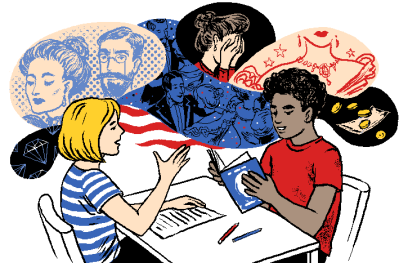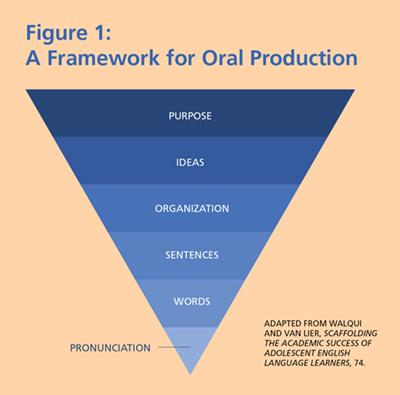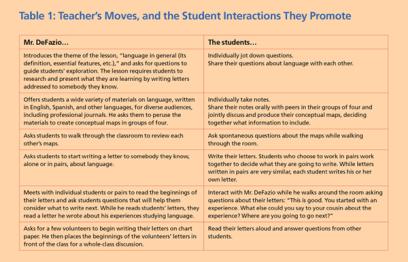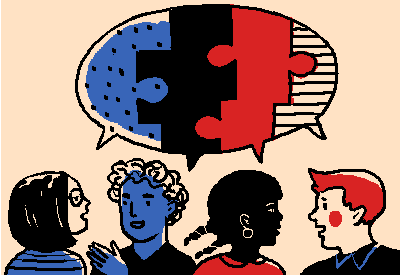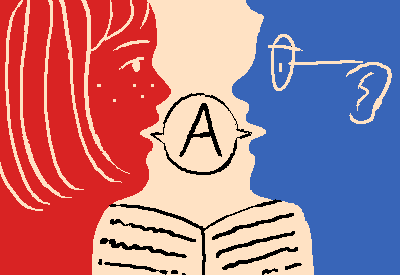Consider this interaction between a teacher and his students, most of them English language learners, in a ninth-grade English language arts class:
Teacher: Who wrote The Pearl, Carmen?
Carmen: Steinbeck wrote The Pearl.
Teacher: Very good. And Rosa, who is the main character in this novella?
Rosa: I guess the main character is Kino, although his wife, Juana, is also important.
Teacher: That’s right. And why do we say The Pearl is a novella? Jim?
Now contrast it with the interaction other ninth-graders had in their English language arts/English language development class:
Teacher: As we begin to explore this short story, “The Necklace,” written by a French author from the 19th century, Guy de Maupassant, I am inviting you to read the first four paragraphs with your partner using types of “Question-Answer Relationships.”* We have practiced this process several times, so unless we require some explanation—[students signal they do not]—then, please get started. As you engage in reading and discussing, I would like you to focus on the character Mathilde and think about what kind of person she is. We will then focus on the problem she faces.
Rodrigo (after reading the first paragraph of “The Necklace” aloud to his partner, Martha): OK, I am going to ask you a “think and search” question. Did Mathilde grow up in a rich family?
Martha: I am not sure. I think no, because the paragraph says she could not marry a “rich and distinguished man” and had to marry a little clerk. Is that an employee? [Rodrigo nods his assent.] I guess it is because she is not rich. But she was very pretty and charming, right?
So now I am going to read the second paragraph. [She proceeds to read aloud to Rodrigo, then pauses and thinks.] I am confused, so I guess I will ask you a think and search question. The text says “with women there is neither caste nor rank, for beauty, grace and charm take the place of family and birth.” Is the author saying that for women, money does not matter? Why did she marry a clerk then?
Rodrigo: Yeah, I agree. I don’t fully understand. You said she was pretty but not rich. Now the second paragraph says that’s in place of family and birth, so does that mean richness? Does it not matter if women are pretty? Does it matter or doesn’t it matter? [Both students decide to raise these questions later during the whole-class discussion. Then Rodrigo proceeds to read the third paragraph to Martha.]
We have all observed classes resembling the first example, where the teacher already knows the answers to the questions being asked, as do most students. The exchange is just an exercise in reiterating the known using complete sentences. In contrast, students in the second example must actively consider the possibilities related to the text, by asking and responding to questions that reveal their understanding.
How do we ensure that all English language learners have opportunities to productively use oral language in academic settings? And how do we ensure that teachers leverage the power of classroom interactions to simultaneously foster language development, content knowledge, and analytical practices? In this article, we offer answers to these questions—and clarify common misconceptions—by presenting guidelines supported by both research and classroom practice.
A Framework for Oral Language
If English language learners (ELLs) are going to productively engage in classroom discourse and express their thinking related to content learning goals, teachers must create a trusting classroom culture in which students feel that whatever level of language they can produce, their contributions will be valued by their teacher and peers and will never be subject to ridicule, sanctions, or negative comparisons.2 Establishing classroom norms such as close listening to understand the ideas ELLs are conveying and showing respect to each other during their interactions (learning, of course, from the models their teachers provide) is essential for successful oral language use. Students need to know that interrupting their peers as they are formulating ideas and finishing their sentences for them are not desirable classroom norms.
As teachers plan to engage students in oral interactions, the framework shown in Figure 1 below can help guide their support for their students’ work and language development. The framework comprises six interconnected levels.
(click image for larger view)
First, teachers need to ensure that students clearly understand the purpose of the interaction they are being asked to undertake. For example, are they supposed to read a text and elaborate their thinking, highlighting what they understand and what they don’t? Are they engaged in describing a scene to somebody who has not seen it? Are they being asked to make a prediction after observing phenomena they will later investigate?
Second, teachers need to make sure students have ideas upon which they will elaborate. For example, have they noticed the most important aspects of the scene (the background, main character(s) presented, what they are doing, other relevant details) on which they will center their description?
Third, teachers need to help students organize their thoughts and ensure their language follows specific patterns. For example, descriptions of a scene from a text cannot begin with sentences such as, “He kicks it, it breaks.” Students need to first indicate the setting of the scene, then introduce the characters, describe them, and explain what they are doing. This sequence is essential to help participants engaged in a conversation paint pictures in their minds. Organization is marked by phrases that can be provided to students as formulaic expressions (which we discuss later in this article) to use:3 “The picture we have shows a…” “We can see a…” “Our scene takes place in a…” “Based on my observation…” “The two historical contexts are…”
Fourth, teachers need to consider the types of sentences students produce and judiciously highlight how they may be combined and expanded to produce more complex language. Increasing complexity can be accomplished with the use of connectors and conjunctions, such as “besides,” “furthermore,” “additionally,” “however,” etc.
Fifth, teachers must pay attention to the words students use. Is one word repeated several times in an interaction? If so, teachers can take the opportunity to introduce a synonym. Do students incorrectly or imprecisely use a term? Teachers can take a moment to clarify usage and meaning.
Finally, when students are ready to present their work to others, teachers can focus on the pronunciation of carefully selected elements—only those that interrupt understanding.
Traditionally, many educators have been taught to focus on correcting student utterances by zeroing in on form and not on meaning. As a result, our framework may initially feel counterintuitive, but the more educators rely on it, the more it will assist them in supporting students’ language growth.
Productive Talk
As a general pattern, we educators often talk too much, no doubt influenced by our “apprenticeship of observation” that began when we were students ourselves.4 However, given the centrality of talk in learning, this pattern needs to change. By some estimates, ELLs spend less than 2 percent of their school day in oral interaction.5 Teachers must find ways to provide students learning opportunities that engage them in productive talk and then listen carefully to the language they use in order to support their continued growth.
By productive talk, we mean speech that has the following characteristics:
- Has depth: the specific idea being discussed is central to the theme of the lesson, is presented in interconnected ways, and engages students’ analytical thinking.
- Is sustained: one student’s statement is followed by another student’s response, which extends, refutes, or questions what was first said.
- Is student controlled: students control what they say, not the teacher. But teachers set up parameters for the interactions, sometimes framing questions that start the conversation. These questions are intended to communicate new related ideas, propose counter ideas or examples, and in general enhance the theme at work.6
Now consider these characteristics in an English for Speakers of Other Languages (ESOL) class, which comprises students with varied levels of English competence.7 “Language” is the theme of the students’ exploration, and this was the third class on the topic. Table 1 below shows the deliberate moves of the teacher, Mr. DeFazio, during the lesson and the students’ interactions. The text in the table indicates the multiple instances of productive talk that he promotes with his directions and actions.
(click image for larger view)
Let us look more closely at a specific interaction that occurred in the lesson after a student, Lavinia, reads the beginning of a letter she wrote about animal communication, and another student, Julio, reacts to one of her statements that animals do not have language.
Julio: Animal communication is not a language? It is a language—that’s what I think—because they are communicating with each other.
Lavinia: But they don’t speak.
Class: [Many students agree with Julio, saying “Yes, they do,” or nodding.]
Julio: You said a language can have words, sounds, gestures, and everything.
Class: [Many students are in agreement with Julio’s ideas once again.]
Lavinia: But they don’t have words. They don’t say “mama.”
Julio: They don’t need to. They have other characteristics. In animal language, some of the characteristics that you said are present—sound, pitch, gestures—so it is a language.
Mr. DeFazio: Julio is arguing very strongly that animal communication is language. Lavinia is saying that it’s not. What do you think would be a way to help them resolve that argument in their writing?
Class: [The discussion continues and a resolution emerges. Then Julio reads a section of his letter.]
Mr. DeFazio: A lot is going to depend on how you define language, OK? You can define it in such a way as to exclude what animals do; you can define it in a very broad way, as a system of communication that includes everything. You are going to find linguists and zoologists who disagree, and if you are interested, I can give you some readings that were in the journal Science last year, people arguing back and forth.
Julio (reading his letter): First of all, I think that language is a way to inform others around you, your feelings, or just a simple thing that you want to let people know what is the deal. And it can be expressed by saying it, looking at a picture, or hearing it, you know what I’m saying? I don’t know if you have heard about the kangaroo rat that stamps its feet to communicate with other rats. It’s really funny ’cause we humans have more characteristics to communicate to each other, but we still have problems to understand other people. Characteristics like sound, grammar, pictures, and body language are some of them, while the rat only uses the foot. [Julio stamps the ground.]
Mr. DeFazio: Excellent! [The class applauds.] I never even heard about the kangaroo rat. Nice job, nice job. [Mr. DeFazio shakes Julio’s hand.]
Applying the framework illustrated in Figure 1 to this interaction, we notice that students are clearly aware that the purpose of this exercise is to compare diverse positions on communication and to debate whether animals have language or not, providing evidence for their positions. They have ideas, and they choose which ones to debate based on a diversity of opinions. Mr. DeFazio’s opportunity to correct student work, suggest changes, ask for elaboration, and so forth comes in the letters he is asking his students to construct. This written product is intimately tied to oral production. Oral activity feeds into writing, and writing produces oral activity.
In terms of productive talk, in Mr. DeFazio’s class, students’ analytic thinking is engaged, their interaction is sustained, and they control what they say. Mr. DeFazio has chosen a theme for the lesson that appeals to the students, and he has deliberately planned their active engagement throughout. As a result, the interaction engages students in deep thinking as they compare views on language.
Now that we have seen the characteristics of quality interactions for ELLs in practice, in the next section, we provide guidelines for promoting quality interactions during content lessons.
Six Guidelines for Promoting Quality Interactions
- Design lessons that involve ELLs’ participation in subject-specific and substantive oral practice to accomplish clearly defined lesson goals: Planning a lesson always begins with establishing the destination: Where do teachers need to lead students? Teachers should ask: Are my goals closely related to content standards? What is the knowledge that will be constructed? Which analytic practice will be promoted? What is the language (beyond isolated words or sentences) that will need to be developed? Unless teachers themselves are clear about the goals of a lesson, they will not be able to plan the tasks and activities that support students’ language and conceptual development.
- Construct tasks that appropriately scaffold student participation and growth: Tasks need to be deliberately constructed to engage students in working beyond their current competence. Such tasks should promote worthwhile interactions for students to acquire new conceptual understandings and analytical skills and language. They should also have appropriate scaffolds, which entail teachers closely observing students to ascertain whether the support is working, whether it is still needed, or whether it needs to be modified or replaced.
- Make sure the task is designed to meet its purposes and the materials used are appropriate to support students working at the edge of their competence successfully: Learning is most effective when tasks are designed to match students’ current competencies and also challenge them to move forward, with support.
- Make sure that activities or tasks follow and precede others logically to build coherent lessons: Leading students to increasingly more complex demands is essential if teachers want their lessons to flow smoothly and to incrementally build ELLs’ understanding.
- Integrate reading and writing into oral development activities: Oral interaction while reading texts not only allows ELLs to understand the text more deeply but also helps them develop awareness of what they understand as they read and what they can do to solve problems in reading.
- Be selective in addressing errors and intentional in providing feedback: When ELLs use English to develop their understanding of content and their use of analytical practices, often their language will be neither accurate nor fully formed, although the intent of their communication will be apparent. Imagine, for a moment, the impact on ELLs’ motivation and self-esteem if teacher responses to inaccuracies constituted a constant flow of error correction. Instead, consider formative feedback to students as invitations to understand how they are progressing in language development and to provide a resource for how they can advance. When feedback is given to students about language while they are learning discipline-specific content, the feedback should focus on language so that students can make sense of the academic content, rather than on correcting errors of language production. As such, feedback can increase the students’ awareness and help them troubleshoot their own performance and eventually correct their own language.8
There is no hard and fast rule about how much feedback students should receive or how often it should be provided; this is a decision teachers will need to make for themselves, given their knowledge of their students, their language and content goals, and the students’ current language use. However, because of the powerful impact that feedback can have on learning,9 we advise teachers to make providing feedback a regular and routine part of their classroom practice.
Common Misconceptions
Designing and facilitating meaningful classroom talk is essential for ELLs—indeed for all students—to develop more extended and sophisticated language use while simultaneously learning subject matter. Yet in too many U.S. classrooms, we find ELLs sitting silently, watching their teachers do all the work, and waiting for opportunities to fully engage cognitively and linguistically.
By way of concluding thoughts, we outline five pitfalls to avoid in thinking about language learning, and we provide suggestions for how teachers can engage students in sustained, high-quality classroom talk.
Misconception 1: Sentence frames that provide students with a way of expressing their ideas about specific situations are helpful to them.
A sentence frame is basically a fill-in-the-blank type of activity that invites only one correct answer. Sometimes it can be open and provide starters for students (also called sentence starters for this reason) to be filled in any way. However, these starters may not provide students with phrases they can use time and time again in academic situations.10 For example: “The main character in The Pearl is a modest and loving man, furthermore…” “His wife, Juana, loves Kino and Coyotito, their baby, and because of that…”
In addition to using sentence frames, we suggest teachers use formulaic expressions, which are phrases that help start or link ideas and can be used in many situations. Initially, students learn them as unanalyzed chunks, almost as if they were one word. Later on, as students learn more English, they begin to realize the formulaic expressions are formed by several words. Formulaic expressions are extremely useful in students’ development of English and in making their interaction with peers possible and more effective. Examples of formulaic expressions are: “I agree with you, and I can add that…” “May I suggest a couple of other ideas? One example I can offer…”
Misconception 2: Correct mistakes students make as they talk or they will “fossilize.”
Historically, correctness has been regarded as paramount in second language learners’ use of English. More recently, however, researchers’ attention has shifted to the larger components of communication, as discussed before: purpose, ideas, organization, types of sentences, vocabulary, and pronunciation. Fossilization, a concept popular in the 1980s, refers to the inability of second language learners to learn the correct forms of language if they continually misuse them. Our perspective, consistent with that of multiple applied linguists, is that language keeps evolving as a result of continuous practice. It may fossilize if it is no longer used productively or receptively. However, in their schooling, students will be invited to engage in uses of language continuously, and thus, they will have ample opportunities to correct themselves or be corrected by others.
Misconception 3: Rather than correcting students’ ungrammatical oral language, it is better to provide them with recasts, which model correct English in response to students’ mistakes.
It is common for teachers to believe that rather than correcting a student’s mistakes—and putting him or her on the spot—it is better to repeat what a student has said, this time changing the student’s utterance into grammatical English. They think that recasting saves a student’s face and that it is a less authoritarian approach.
Research, however, shows that these implicit corrections may not be productive.11 Students do not take teachers’ recasts as corrections, but rather as reiterations of the idea and as acceptance of students’ comments as being right. When the time is appropriate to focus on selected language forms to study and correct, the correction and expansion activity needs to be made explicit.
Misconception 4: Sustained, focused interactions are possible starting in fourth or fifth grade, but lower elementary students are not mature enough to carry them out because they get too impatient with the task and with each other.
Recently, during an open house at an elementary school in Portland, Oregon, one of us (Aída) had the opportunity to visit three classes. The first one was a kindergarten class. The teacher, Mr. Andanen, was preparing students to read and discuss Julius, the Baby of the World, a book by Kevin Henkes, an author the students were already familiar with because they had enjoyed reading three of his other books in class.
To introduce the book, Mr. Andanen set up nine stations around the room and invited students to walk through them. At each station, a picture illustrating a scene from the book was prominently displayed. Students were asked to rotate around the stations every three minutes. At each station, students needed to stop, look at the picture, and explain what they noticed. The teacher had asked students to use a “talking stick” so that the turns to speak were democratically divided within the group at each station. Peers had to listen attentively to the speaker and agree with, disagree with, or expand on what the student said. Formulaic expressions such as “In this picture, I notice…” and “I noticed that, too, and I want to add…” were familiar to the group. At one station, Aída heard the following exchange:
Student 1: I notice a woman holding a big baby. Her mouth is open. I think she is crying.
Student 2: I also noticed she had her mouth open, but I don’t think she is crying. I think she is singing.
Student 3: I also noticed the woman with the big baby, and I want to add that he is very heavy. Perhaps that is why she is screaming.
The exchange shows that Mr. Andanen has created an environment that enables young children to notice and use language in purposeful ways. Although the students were only in kindergarten, they clearly articulated their ideas and listened to others. They showed they will soon be ready to start exploring the book more deeply so that they can eventually write an opinion piece based on evidence from the text about which Henkes book was their favorite.
Misconception 5: All students in a class need to master the same levels of oral development as a result of participating in lessons.
Because not all students in a class will be at the same starting point, a robust activity provides multiple entry points for all students to engage as they learn. The important idea is that they should all be gaining—not that all of them will arrive at the same point, in exactly the same way, developing at exactly the same level. This would only be possible if what is learned is limited, and if the learning demands recall. This is not necessarily what we want in education. Rather, we want to produce individuals who are thoughtful, engaged, and conscious of their own development.
English language learners bring valuable assets and immense potential to school. The role of educators is to realize that potential in deep and accelerated ways. Each classroom teacher must ensure the path to that development is paved with meaningful interactions to help students develop language skills, gain conceptual understanding, and learn academic content. Our students deserve no less.
Aída Walqui is the director of the teacher professional development program at WestEd. Previously, she taught in the Division of Education at the University of California, Santa Cruz, and at the Stanford Graduate School of Education. Margaret Heritage is a senior advisor at WestEd and was previously an assistant director at the National Center for Research on Evaluation, Standards, and Student Testing at the University of California, Los Angeles.
*Taffy Raphael’s Question-Answer Relationships framework1 is intended to call students’ attention to the kinds of questions that may be asked about a text. In this class, students work in pairs, announcing first the type of question he or she will ask to increase the other student’s awareness of the types of meaningful connections the question seeks. (back to the article)
Endnotes
1. Taffy E. Raphael, “Teaching Question Answer Relationships, Revisited,” The Reading Teacher 39 (1986): 516–522.
2. Alison L. Bailey and Margaret Heritage, Progressing Students’ Language Day by Day (Thousand Oaks, CA: Corwin, 2018).
3. See Rod Ellis, Instructed Second Language Acquisition: A Literature Review (Wellington, New Zealand: Ministry of Education, 2005).
4. Dan C. Lortie, Schoolteacher: A Sociological Study (Chicago: University of Chicago Press, 1975).
5. Diane August, referenced in Ivannia Soto-Hinman, “Increasing Academic Oral Language Development: Using English Language Learner Shadowing in Classrooms,” Multicultural Education 18, no. 2 (Winter 2011): 21–23.
6. Aída Walqui and Leo van Lier, Scaffolding the Academic Success of Adolescent English Language Learners: A Pedagogy of Promise (San Francisco: WestEd, 2010).
7. Anthony DeFazio and Aída Walqui, Where Do You Want to Go Next? (San Francisco: WestEd, 2001), DVD.
8. David J. Nicol and Debra Macfarlane‐Dick, “Formative Assessment and Self‐Regulated Learning: A Model and Seven Principles of Good Feedback Practice,” Studies in Higher Education 31 (2006): 199–218.
9. See, for example, John Hattie and Helen Timperley, “The Power of Feedback,” Review of Educational Research 77 (2007): 81–112.
10. For more on sentence frames, see Ellis, Instructed Second Language Acquisition.
11. Ahlem Ammar and Nina Spada, “One Size Fits All? Recasts, Prompts, and L2 Learning,” Studies in Second Language Acquisition 28 (2006): 543–574; Ellis, Instructed Second Language Acquisition; and Roy Lyster, “Differential Effects of Prompts and Recasts in Form-Focused Instruction,” Studies in Second Language Acquisition 26 (2004): 399–432.

